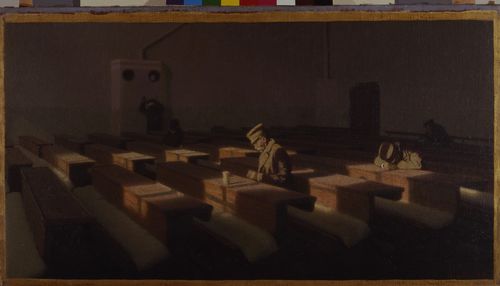After more than a century, Angelo Morbelli’s pictorial cycle, Il poema della vecchiaia (The Poem of Old Age), one of the Divisionist artist’s masterpieces, has been completely reassembled after being split up in 1906. In 1901 Morbelli confided to his friend Giuseppe Pellizza da Volpedo his desire to return to the theme of old age, with the explicit intention of creating a true series of paintings. The result of this new approach to a subject he had addressed since 1883, was presented as a cycle of six works at the 5th Venice Biennale in 1903, listed in the exhibition catalogue as Il poema della vecchiaia. The six canvases: Il Natale dei rimasti, Vecchie calzette, Mi ricordo quand’ero fanciulla, Siesta invernale, Sedia vuota e I due inverni were specifically made for the Venetian exhibition and depict various environments at the Pio Albergo Trivulzio in Milan, the largest home for the poor and elderly in the city. Morbelli returned there to paint and experiment, having already portrayed the home in works from the 1880s. To do so, he obtained a dedicated space in the home where he set up an atelier, an indispensable condition for closely studying the psychological mechanisms inherent in the patients’ melancholy rituals. Numerous preparatory studies, drawings and photographs testify to the rigorous approach he followed, based on the Divisionist technique in which light and pigments are carefully calibrated to produce the luminous impression. The recent return to Europe of Vecchie calzette (Old Socks), the only canvas of the cycle ever to appear in public since 1906, has enabled the paintings to be reunited for the first time since the 1903 Biennale, and arranged just as they were originally hung in 1903 in the Sala Lombarda of the Exhibition Palace in the Giardini. The exhibition at Ca’ Pesaro, which holds one of the six canvases in its collection, purchased at the 5th Biennale, marks the return to Venice of a key work by the great artist, and restores a vision of the lost Poema to the public and to scholars.
Angelo Morbelli. The Poem of Old Age, exhibition at Venice. Information about Angelo Morbelli. The Poem of Old Age exhibition, the curators, the opening times, ticket prices, the numbers for reservations, the press release about the exhibition of the Ca’ Pesaro – Galleria Internazionale d’Arte Moderna museum of Venice.
Map
- City: Venice
- Province: Venice
- Address: Santa Croce 2076
- Phone#: +39 041 721127
- E-Mail info
- Official site
Scheda Mostra
Angelo Morbelli. The Poem of Old Age
Angelo Morbelli
- Place: Ca’ Pesaro – Galleria Internazionale d’Arte Moderna
- Responsibles: Giovanna Ginex
- City: Venice
- Province: Venice
- Start date: 20 October 2018
- End date: 6 January 2019
- Ticket price: full € 10, reduced € 7.50
- Telefono per informazioni: +39 041 721127
- E-Mail info
- Official site








